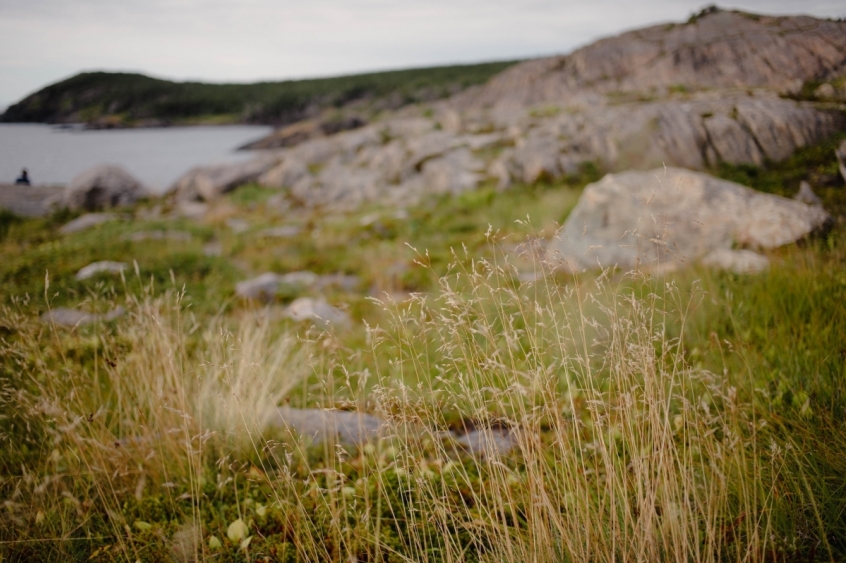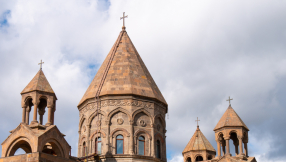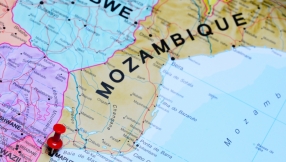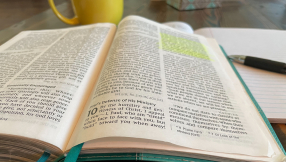
The writer of the Letter to the Hebrews reminds Christians that they are surrounded by a great "cloud of witnesses." (NRSV) That "cloud" has continued to grow in size since then. In this monthly column we will be thinking about some of the people and events, over the past 2000 years, that have helped make up this "cloud." People and events that have helped build the community of the Christian church as it exists today.
Considering who were the first Christians in North America seems particularly appropriate in November, as this is the month in which the US remembers the first 'Thanksgiving' of the Mayflower Pilgrims in 1621, following their first successful harvest.
Three questions – and their unexpected answers
Today, if one asked a citizen of the USA or Canada to name the first Christian buried in North America, they might suggest the name of one of the settlers who sailed to Jamestown, Virginia, in 1607. If an actual name did not spring to mind, they might suggest that such a person must have accompanied that voyage, or one of the other early European ventures which made landfall from the sixteenth century onwards.
Asked who was the first Christian born in North America, they might suggest a Spanish colonist or perhaps a Mayflower settler. Asked when the first Native American was baptized as a Christian, they might name Pocahontas, who converted to Christianity in Virginia in the early seventeenth century.
It is highly unlikely that anybody would suggest that the answer to the first question is: Thorvald Eriksson, brother of Leif "the Lucky" (aka Leif Eriksson) of Viking-age Greenland.
Or that the answer to the second question is: Snorri Thorfinnsson, the child of Thorfinn Karlsefni and Gudrid Thorbjornsdottir, who had sailed to North America from Brattahlid on Greenland a thousand years ago. Or that the answer to the third question is: two children, captured on "Markland" (probably Labrador) by the companions of Thorfinn Karlsefni and Gudrid Thorbjornsdottir.
The fact that all these named-people lived in the early eleventh century, and were Norse, would astonish many people. However, according to Icelandic sagas, these are the names that are the answers to those three questions. Furthermore, evidence discovered in the twentieth century gives us a great deal of confidence in the general witness of the medieval saga accounts. For, traditions that were long dismissed as Norse tall tales are now corroborated, in outline at least, by the findings of archaeology. The Norse were, indeed, the first Christians anywhere in the Americas.
The Viking discovery of North America
Two thirteenth-century Icelandic sagas tell the remarkable stories of Viking-age voyages to North America. These sagas are Erik the Red's Saga and Saga of the Greenlanders. Together they tell the story of the discovery of a place called "Vinland" that was located to the west of the Norse settlements in Greenland. The accounts differ in several ways, but they are remarkably precise when it comes to descriptions of topography.
The western lands that were discovered according to these medieval accounts were for a long time regarded as legendary and the products of thirteenth-century Icelandic imagination. That has changed over the last century. As a result of more critical study of the medieval texts themselves, comparison of their accounts with the geography of North America, and conclusive archaeological evidence of Norse settlement in Canada, it is now clear that Norse voyages this far west did indeed occur.
The archaeological evidence comes from a coastal site, known as L'Anse aux Meadows, on the northern tip of Newfoundland, Canada. Discovered in the 1960s, the buildings and artefacts found there constitute indisputable evidence of Viking settlement in North America. Furthermore, some finds from the site (butternuts and types of wood) indicate that the Norse explorers travelled further down the coast, at least as far south as New Brunswick, and very possibly into northern New England. A Viking-Age coin, found in 1957 on a Native American trading site in Maine, adds to other Norse finds, from the Canadian arctic and sub-arctic, as evidence of Viking-age journeys to North America.
We cannot be certain but there is a likelihood that the site at L'Anse aux Meadows may correspond to the camp called "Straumfjord" in the Norse sagas. What is clear is that Scandinavians crossed the wild seas of the North Atlantic and were the first recorded European discoverers of North America.
They did this almost five centuries before the voyages of Christopher Columbus, and those who followed him. The first recorded European landing in the Americas was a Viking achievement and one accomplished by Scandinavian adventurers who included Christians among their number. These were, indeed, the first Christians to reach the Americas.
The first "American Christians"
According to the saga accounts, the voyages to Vinland took place at an important point in the history of Christian conversion in the North Atlantic. This was because it was in AD 1000 that Iceland officially converted to Christianity, after a period of tension between Christianity and the pagan beliefs of the Viking inhabitants. Christian influence increased within the Norse settlements on Greenland at about the same time.
The account found in Erik the Red's Saga includes a woman named Gudrid Thorbjornsdottir, who had relocated from Iceland to Greenland, and who is explicitly described as a Christian. It was about this time that King Olaf Tryggvason of Norway organised a mission to convert the Greenlanders to Christianity. However, Gudrid was already a believer. A later arrival in Greenland, named Thorfinn Karlsefni, married the (by now widowed) Gudrid and they decided to emigrate to the newly discovered Vinland and take their livestock with them.
The sagas describe tensions among the settlers in Norse America, which reveal the conflicting Christian and pagan beliefs held by different members of one of the expeditions. They hit trouble as they lacked sufficient provisions and there were disagreements within the group between Christians and pagans over what was causing their problems and how best to respond to the crisis.
The writer of Erik the Red's Saga explained that the explorers prayed to God but one of their number, Thorhall the Huntsman, rejected their reliance on Christian faith and claimed that a beached whale they had found was a reward for his composing a poem in honour of the pagan god Thor. Thorhall remarks: "Didn't Old Redbeard [Thor] prove to be more help than your Christ?" But the whale meat made them sick and so they threw it away and called on the mercy of God. Eventually, improved weather, abundant fish stocks, game to hunt, and eggs to gather saved them from starvation.
The saga-writer went on to say that Thorhall the Huntsman – who continued to compose pagan poetry, this time to Odin – was eventually driven ashore in Ireland by storms and was there enslaved. This was clearly stating a Christian verdict on his paganism.
The saga literature also contains a record of the first Christian buried in North America. An account of the death of an explorer named Thorvald Eriksson includes a mysterious warning concerning an attack by Native Americans (called skraelings by the Norse) through the intervention of an unidentified voice. We are not sure whether the compiler intended this to be identified as fate (prevalent in Old Norse pagan beliefs) or a warning from the Christian God. It was possibly a mix of the two.
What comes next, though, is unambiguous. Thorvald Eriksson received a fatal arrow wound. But, before he died, he requested that he be buried in the newly-explored land, with the significant detail that his companions should "mark my grave with crosses at the head and foot". For this reason, the spot was remembered as "Krossanes," which means "Cross Point" in Old Norse. With this telling detail we have the first record of any Christian buried in North America. It is not now possible to identify where this took place.
The sagas also record the first child born to a Christian family in America. Just before the start of her second winter at their settlement site, Gudrid Thorbjornsdottir gave birth to a son: Snorri Thorfinnsson. No other births are recorded, as the settlement could not be sustained in the face of conflict with Native Americans; and because the settlers were too few in number and Norse Greenland did not have a large enough population to reinforce them.
However, this is not the last we hear of the intrepid Gudrid. The saga evidence gives us some more information about her following her adventures in Vinland. She and Thorfinn Karlsefni took trade goods to Norway and then eventually settled in northern Iceland. After Thorfinn Karlsefni died and their son, Snorri, got married, Gudrid made a pilgrimage to the south. It is likely that Rome is implied, but the saga-writer was not explicit about this. When she returned to Iceland, she found that Snorri had built a church at their farm, where she lived out her days as a Christian anchoress (one living a solitary life of prayer). From Snorri were descended three bishops in the later Icelandic church. That her story ends this way reveals the Christian faith of the compiler and the role of Christianity within the lives of this family of Vinland explorers.
After this, Vinland slipped into a half-remembered world until the archaeological discoveries of the twentieth century. Today, though, we know that there were "American Vikings", and these included the first Christians to reach North America.
Martyn Whittock is an evangelical historian and a Licensed Lay Minister in the Church of England. The author, or co-author, of fifty-six books, his work covers a wide range of historical and theological themes. In addition, as a commentator and columnist, he has written for several print and online news platforms and been interviewed on TV and radio news and discussion programmes exploring the interaction of faith and politics.
His most recent books include: Daughters of Eve (2021), Jesus the Unauthorized Biography (2021), The End Times, Again? (2021), The Story of the Cross (2021), and Apocalyptic Politics (2022). In his co-written book The Vikings From Odin to Christ (2018), he explored the conversion of the Norse of the Viking Age to Christianity. It is a theme which reoccurs in his latest book American Vikings. How the Norse Sailed into the Lands and Imaginations of America (2023).













